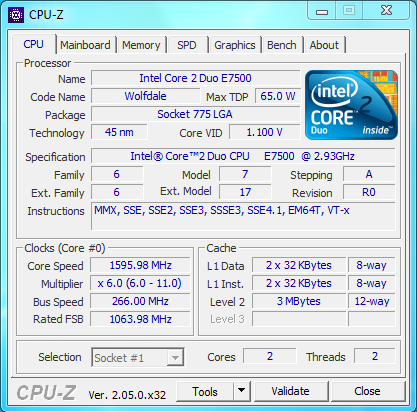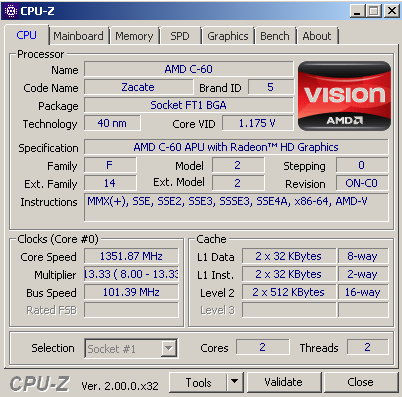Comparing: AMD C-60 vs Intel Core 2 Duo E7500
In this comparison, we analyze two Processors: AMD C-60 and Intel Core 2 Duo E7500, using synthetic benchmark tests to evaluate their overall performance. This side-by-side comparison helps users understand which hardware delivers better value, speed, and efficiency based on standardized testing. Whether you're building a new system or upgrading an existing one, this benchmark-driven evaluation offers valuable insights to guide your decision.

Intel Core 2 Duo E7500
| Type: | Processors |
|---|---|
| Brand: | Intel |
| Model: | Core 2 Duo E7500 |
Specification Comparison Table
This specification comparison presents technical details of several devices or components to help you understand the key differences between each option. Use this table as a reference to determine which device best suits your needs.
| Specification | AMD C-60 | Intel Core 2 Duo E7500 |
|---|---|---|
| Architecture | x86 | x86 |
| Technology | 40 nm | 45 nm |
| Clock | 1 GHz - 1.3 GHz | 2.93 GHz - - |
| Core/Thread | 2 / 2 | 2 / 2 |
| Segmen | Mobile | Desktop |
Submission Comparison Table
This submission comparison table displays the number and details of benchmark data submissions from various devices or components. This information helps you understand the performance based on the benchmarks that have been tested, as well as providing an overview of the consistency and popularity of the available benchmark results.
| No. | Benchmark Software | AMD C-60 | Intel Core 2 Duo E7500 |
|---|---|---|---|
| 1 | PiFast |
2min, 14sec, 820ms |
34sec, 90ms |
| 2 | SuperPi - 1M |
1min, 139ms |
18sec, 470ms |
Submission Comparison Chart
This chart visualizes the benchmark scores comparison between two hardware devices based on submitted data.
Media Gallery
A collection of photos of tested hardware. These images can help you identify the physical form, model, and variant of the hardware in question. These photos are from our own documentation, and if they are not available we may not be able to document them.
About Hardware AMD C-60
Released in 2011, the AMD C-60 is a power-efficient processor from the Ontario series built on the Bobcat architecture. It has 2 cores and 2 threads, with a base speed of 1.0 GHz that can be increased to 1.33 GHz through Turbo Core technology. Designed specifically for portable devices such as netbooks and ultraportable laptops, the C-60 is focused on power efficiency and long battery life rather than high performance. With a TDP of just 9 watts, this processor enables ultra-thin and lightweight laptop designs without the need for complex active cooling systems. The main advantage of the C-60 is its extremely low power consumption, making it an attractive solution for users who need a lightweight computing device for daily activities with high mobility.
The AMD C-60 is also equipped with an integrated Radeon HD 6290 GPU, which has 80 shader cores and supports DirectX 11. Despite its modest specifications, this GPU is sufficient for multimedia purposes such as HD video playback, light graphics rendering, and old-school games with minimal graphics settings. However, overall, the performance of the AMD C-60 is limited and only suitable for light tasks such as browsing, typing documents, and using basic office applications. This processor will feel slow when used for heavy multitasking, modern software installation, or complex web-based applications. In tests using an Acer Aspire One 522 paired with 2GB DDR3 RAM and Windows 7 operating system, the processor was able to provide a decent user experience for basic needs, but was less responsive when compared to mainstream processors of the same generation. Even so, the AMD C-60 remains a viable solution for low-cost, power-efficient devices of its time.
Hardware Detail:
Device: Acer Aspire One 522
RAM: 2GB DDR3
OS: Windows 7
Friday, 08 April 2022 17:00:00 | Update: 1 month ago
About Hardware Intel Core 2 Duo E7500
The Intel Core 2 Duo E7500 is a desktop processor released in 2009, based on the Wolfdale architecture, which is part of Intel’s Core 2 Duo family. It features 2 cores and 2 threads, running at a clock speed of 2.93 GHz, and operates with a 1066 MHz Front Side Bus (FSB).
Manufactured using 45nm process technology, the E7500 has a TDP of 65W, which was considered energy-efficient for its time. However, this processor does not support Hyper-Threading or Turbo Boost, meaning its performance is limited to strictly single-threaded and basic dual-threaded applications.
In terms of modern computing standards, the Core 2 Duo E7500 is outdated and performs well below current entry-level processors. Despite this, it can still be useful in legacy systems for light workloads such as basic web browsing, office documents, and 480p–720p video playback, especially when paired with a lightweight operating system.
Thursday, 09 March 2023 02:31:57 | Update: 1 month ago


